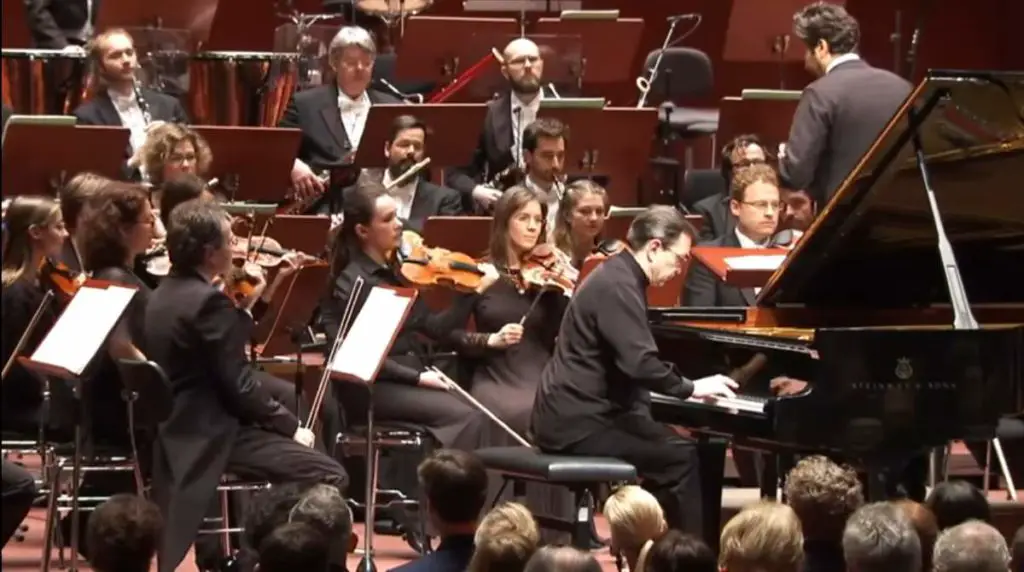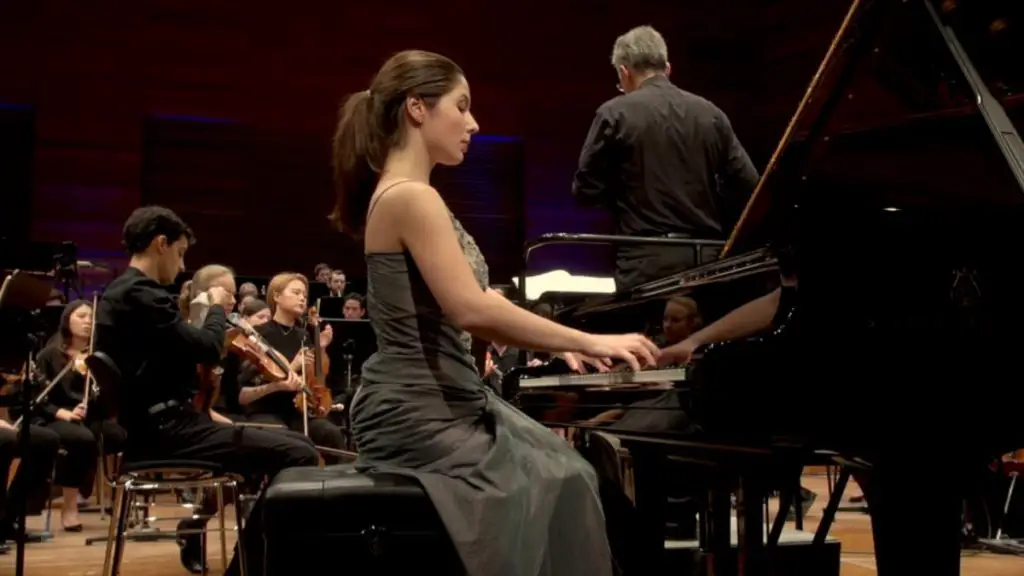Accompanied by the Duisburger Philharmoniker (Duisburg Philharmonic Orchestra), Spanish pianist Rosalía Gómez Lasheras performs Ludwig van Beethoven’s Piano Concerto No. 5 in E-flat major, Op. 73, popularly known as the “Emperor Concerto”. Conductor: Joseph Bastian. This performance was recorded in Dortmund in 2018.
Ludwig van Beethoven’s Piano Concerto No. 5 “Emperor”
Beethoven’s Piano Concerto No. 5 in E-flat major, Op. 73, commonly referred to as the “Emperor” Concerto, stands as a testament to Beethoven’s musical genius and his ability to infuse classical forms with new levels of expressiveness.
Composed between 1809 and 1811, this concerto was written during a turbulent period in Vienna due to the Napoleonic Wars. However, it’s worth noting that Beethoven himself did not give the concerto its popular nickname “Emperor”. This title was coined by Johann Baptist Cramer, an English publisher, and it became associated with the work likely due to the majestic and grandiose nature of the music.
The “Emperor” Concerto was Beethoven’s last completed piano concerto and is considered by many to be the pinnacle of his concerto works. It marks a departure from the more classical style of his earlier concertos, showcasing a mature composer with a forward-looking vision.
This concerto exemplifies Beethoven’s transition from the Classical to the Romantic era, with its expansive form, innovative harmonies, and an emphasis on the virtuosic interplay between the soloist and the orchestra. Interestingly, due to Beethoven’s declining hearing, he did not perform the piece himself; instead, the premiere in Leipzig in 1811 featured the German pianist Friedrich Schneider (1786-1853) as the soloist.
Movements
1. Allegro
The first movement of Beethoven’s Piano Concerto No. 5, the “Emperor,” is marked “Allegro,” and it is both grand and expansive in its nature. The movement opens with a bold statement: instead of the traditional orchestral introduction that was customary for concertos of the time, Beethoven lets the piano take the lead.
The soloist presents three emphatic, virtuosic cadenzas right at the outset, which are then echoed and developed by the orchestra. This novel beginning sets the tone for a movement that is characterized by its dialogue between the soloist and orchestra, a testament to Beethoven’s innovative approach to the concerto form.
Throughout this movement, Beethoven showcases a rich array of themes and motifs, each presented and developed with the composer’s typical mastery. There’s a striking contrast between the majestic, rhythmic motifs and the lyrical, flowing melodies that interweave throughout.
The structure of the movement is in the typical sonata-allegro form, with exposition, development, and recapitulation sections. However, Beethoven’s treatment of these sections, especially the extended development, is far from conventional. He skillfully plays with the musical material, constantly evolving and transforming themes as they pass between the piano and the orchestra.
A particularly notable aspect of this movement is the balance Beethoven achieves between the virtuosic demands on the soloist and the integral role of the orchestra. Neither overshadows the other; instead, they work together in a collaborative display of musical exploration and expression. The movement concludes with a sense of triumph and resolution, setting the stage for the subsequent movements of the concerto.
![Beethoven: Piano Concerto No. 5 [Zimerman, Bernstein, Wiener Philharmoniker]](https://cdn-0.andantemoderato.com/wp-content/uploads/2023/04/Beethoven-Piano-Concerto-No-5-Zimerman-Bernstein-Wiener-Philharmoniker-1024x567.jpg)
2. Adagio un poco mosso
The second movement of Beethoven’s Piano Concerto No. 5, “Emperor,” is marked “Adagio un poco mosso,” and it offers a serene and introspective contrast to the vigor of the first movement.
This movement is characterized by its lyrical beauty and profound emotional depth. It begins with soft, delicate strings that introduce a gentle, heartfelt theme. As this theme unfolds, the piano enters, not with grandeur as in the first movement, but with a sense of introspection and grace. The dialogue between the orchestra and the piano here is delicate, almost like a whispered conversation between old friends.
The harmonic language of this movement is rich and evocative. Beethoven employs modulations and chromaticism to enhance the emotional impact, painting a soundscape that can evoke feelings of nostalgia, longing, and tranquility in the listener. The melodies are elongated and flowing, allowing the soloist to indulge in expressive phrasing and delicate ornamentation.
There’s an ethereal quality to this movement, and one can sense Beethoven’s penchant for exploring the deeper realms of human emotion. It’s as if the music provides a momentary pause, a respite from the world’s tumult, inviting listeners to reflect and find solace in beauty.
As the movement draws to a close, the music subtly transitions without a break into the third movement, maintaining the continuity of the concerto and preparing the listener for the final exuberant chapter of this musical journey.
3. Rondo – Allegro ma non troppo
The finale of Beethoven’s Piano Concerto No. 5 is marked “Rondo: Allegro,” and it bursts forth with a sense of joy, energy, and optimism. After the introspective nature of the second movement, this rondo feels like a jubilant awakening, bringing the concerto to a lively conclusion.
The movement is structured as a rondo, a musical form characterized by the recurring return of a main theme (the “refrain”) interspersed with contrasting sections. The piano introduces the primary theme, a buoyant and catchy melody, which sets the tone for the entire movement.
Throughout the rondo, the interplay between the soloist and the orchestra remains dynamic and playful. The contrasting episodes between the recurrences of the main theme provide opportunities for both the orchestra and the soloist to introduce new musical ideas and develop previously introduced material. These episodes often showcase the piano’s virtuosity, with Beethoven writing intricate and fast-paced passages that demand dexterity and precision from the soloist.
As the movement progresses, Beethoven employs a variety of harmonic and rhythmic tricks to keep the listener engaged, playing with expectations and often surprising with unexpected twists and turns. This gives the rondo a sense of freshness and spontaneity, even as the familiar refrain returns time and again.
The culmination of the movement is a testament to Beethoven’s ability to build tension and excitement. As the final statements of the rondo theme are presented, the music accelerates, leading to a brilliant and exhilarating conclusion, rounding off the “Emperor” Concerto on a triumphant note.
Sources
Piano Concerto No. 5 (Beethoven) on Wikipedia

